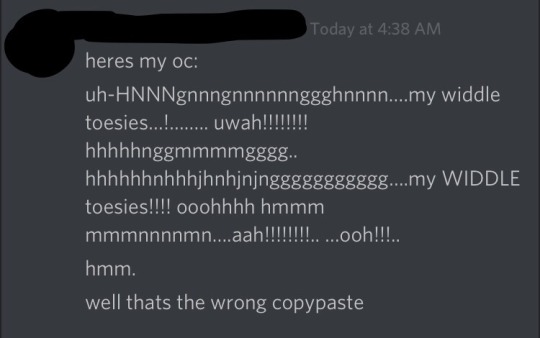Text
72K notes
·
View notes
Text




A baby Malayan tapir named Ume (via Point Defiance Zoo)
78 notes
·
View notes
Text

This will never make it in front of right-wing eyes. The government is a mystery of spending that can not be understood!
And it’s all because of trans people!
Or immigrants!
Whatever the enemy of the week is… enemy of the weak? 🤔
10K notes
·
View notes
Text
How To Shop For Fabric Online
RIP Joann's. Now many places in the US no longer have a local fabric store, such as it even was toward the end.
There are some good posts going around about where to shop for fabric and craft supplies online, like this one for example. But if you're a beginner-to-intermediate sewist, and the way you've always shopped for fabric is by going to the store and touching it, it can be a hard, even cruel adjustment to suddenly be looking at a photo online and trying to piece together from the inconsistent descriptions what you're actually looking at.
So I'm going to just try to bang together a little primer on What Things Are Called, and how to educate yourself, so that you don't have to do what I did and just buy a ton of inappropriate stuff you wound up not being able to use for what you'd thought. And I will link to some resources that will help with this. This will be garment-sewing-centric but will, I think, be fairly broadly applicable.
The first thing is to look carefully at your desired project. If it is a commercial pattern, it will usually tell you what kind of fabric you need, but it will describe it in not the same words it's often sold under. If it is NOT a commercial pattern and you're kind of winging it, it's even harder. So here is how to start figuring out what you need.
Number one: Knit or Woven?
Quilting fabric is woven. If you are making a quilt, you want a woven. Most craft projects are made with woven fabric-- tote bags, upholstery, you name it.
Many garments are knits. T-shirts, yoga pants, cardigans. It is easy to know, because knits stretch. They can either stretch both ways (along the length and along the width) or just one way (usually along the width); this is confusingly either called 2-way stretch or 4-way stretch. Yes, stores are inconsistent. Look carefully at the description, and they will usually specify-- "along the grain" or "in all directions". Some garments require stretch only around the body-- maxi skirts, knit dresses etc-- while some absolutely need stretch both ways, like bathing suits.
No, you absolutely cannot clone your favorite knit t-shirt in quilting cotton. It will not fit. Most knit garments have "negative ease", meaning they are smaller than your body and stretch to fit. All woven garments have "positive ease", meaning they are larger than your body, unless very firm shaping undergarments are used.
SMALL EXCEPTION: There exist "stretch wovens", which are woven fabrics made with elastic fibers. These will be labeled as such. They are actually harder to sew with than regular wovens because they almost never have their stretch percentage labeled; they are NOT suitable for knit patterns. Avoid them, until you are more advanced and know how to accomodate them, is my advice!
Number two: WEIGHT.
How heavy is the fabric? How thick? How thin? This is measured in two main ways-- ounces per yard (denim is often 8oz, 10 oz, 12 oz) or grams per square meter. But many fabric retailers do not tell you a weight, they use words like "bottomweight" or "dress-weight", and you have to learn to figure out what they mean by that.
My lifehack for learning these has been go to go to ready-to-wear clothing retailers and see if they give the weights of the fabric their garments are made from. (Yes, I learned how to shop for clothes online instead of in-store years ago, because I am fat; some of us have had to do this a long time.)
If you are making a pair of trousers, you need heavier fabric than if you are making a blouse. Do not buy a floaty translucent chiffon to make your work trousers, it will not work no matter how cute the color is. Learn how the different weights of fabric are described, and you will improve your odds of finding what you need.
Number three: DRAPE.
Is it stiff? Is it fluid? Is it soft? is it firm? There are a lot of very artsy words used for this, and you may find yourself puzzling over things with a fluid hand, or a dry, crisp hand, or "a lot of drape", or maybe the listing doesn't describe it at all. This segues neatly into another technical thing, which is the WEAVE of the fabric. There is a dizzying array of words that tell you what kind of fabric it is-- twill, tabby, challis, chiffon, crepe, organza, georgette. And these will give you insight into the drape, and thus into the texture/usability of this fabric, and how suitable it may or may not be for your project.
I know it's a lot to think about but I am now going to give you resources for where to see all this stuff.
Number one is Mood Fabrics, which I can't believe hasn't been in any of the posts I've seen so far. They are a huge store in NYC's Fashion District and yes you can go there, but when I went there it overwhelmed me so much I left empty-handed. But what they have is AN INCREDIBLE WEBSITE. They have everything on there, and what's most important for you, their listings are INCREDIBLY consistent. They have VIDEOS of many of the fabrics, where a sales associate will hold it, wave it, stretch it, and tell you verbally what it is and what it's for, in about thirty seconds. HUNDREDS of these videos.
Whether you want to buy from them or not, go to Mood Fabrics, click around, find their listings, and read them. They will tell you fabric content, weight (usually gsm), often weave, they have little graphics that show you if it's for pants, dresses, shirts. And they have those videos. Look at the listings, watch the videos, and you will leave knowing a lot more about how to look at an online listing of fabric and know what you're getting.
Another really excellent website for this is Stonemountain & Daughter. I've actually not bought anything from them yet (they came highly recommended, but they're not cheap), but their online listings are, again, very thorough and very detailed. They always have a picture of the fabric with a fold in it held in place by a pin, which does more to help you understand the weight and drape of a fabric than any other static image ever could-- that visual, combined with how informative the listings are, has helped me learn to estimate fabric weights on other sites very effectively.
And here is a page that's ostensibly about how to wash silk, but I found it so useful because it gives such a clear image of what each weave/type of silk fabric looks and drapes like. I've never bought anything from these guys either, but this is a good resource.
Learn a little bit about fabric so you know what you're looking for, and you can begin to replace some of that "i just have to go and feel it in person" problem. There will still be trial and error, but you'll have a better starting place at least.
4K notes
·
View notes
Text
I’m all for fucking around and finding out but in this situation (trump & the billionaires trying to drag america into tech bro fascist hell) too many people are being hurt and too many more WILL die if things do not change. you do not need to forgive those who voted for him, you do not need to find the sympathy to feel bad for them now that they’re being affected by his policies. but we cannot turn them away once they turn on trump— and they are. too little too late, maybe. studying for the test after they failed, sure. but I’m so serious when I say this is not the time for perfectionism. this is the time to push a dictator & his cronies out with any hands that are willing to shove
17K notes
·
View notes
Text
Texas’ HB 3399 bill will kill people if it passes. It will make hormone therapy illegal. For all ages. Period. This was never about women’s sports. It was never about bathrooms. It was never about “protecting the children”. They want us dead. If you’re a fellow trans person and you live in Texas, I strongly urge you to be ready to move somewhere safer.
38K notes
·
View notes
Text
On November 7, 2024, Denmark used a racist, culturally biased "parenting competency" test to remove a 2 hour old baby, Zammi, from her loving indigenous Greenlandic Inuit mother, Keira, because her native language, which uses minute facial expressions to communicate, will not be able to "[prepare] the child for the social expectations and codes that are necessary to navigate in Danish society." This test had been recommended not to be used at the federal level before this happened but certain municipalities, including the one this happened in, chose to continue to use it regardless. Not only is this blatantly racist but also violates multiple declarations and conventions that Denmark has signed that protect the rights of indigenous people.
Please sign this petition to help Keira to get her baby back.
48K notes
·
View notes














